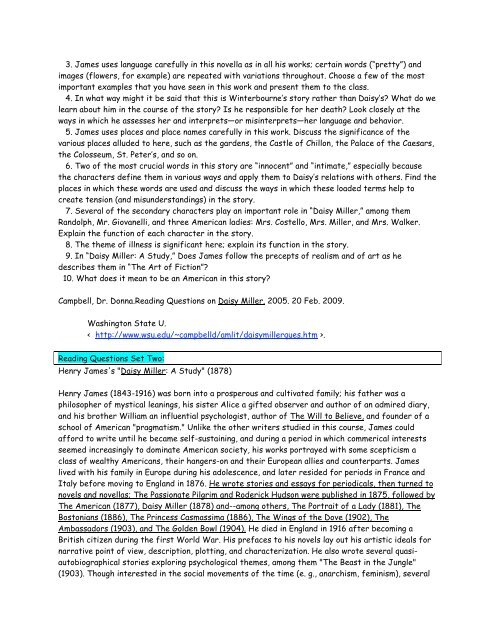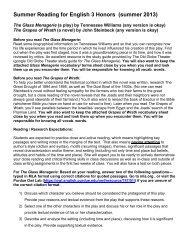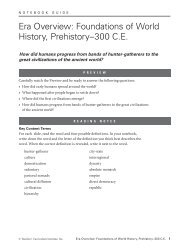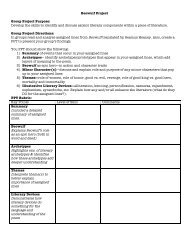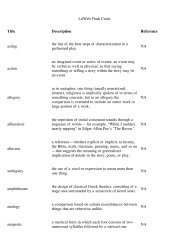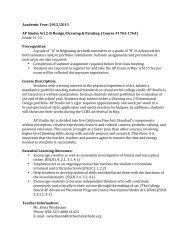DAISY MILLER HONORS ENGLISH Please read through these ...
DAISY MILLER HONORS ENGLISH Please read through these ...
DAISY MILLER HONORS ENGLISH Please read through these ...
Create successful ePaper yourself
Turn your PDF publications into a flip-book with our unique Google optimized e-Paper software.
3. James uses language carefully in this novella as in all his works; certain words (“pretty”) and<br />
images (flowers, for example) are repeated with variations <strong>through</strong>out. Choose a few of the most<br />
important examples that you have seen in this work and present them to the class.<br />
4. In what way might it be said that this is Winterbourne’s story rather than Daisy’s? What do we<br />
learn about him in the course of the story? Is he responsible for her death? Look closely at the<br />
ways in which he assesses her and interprets—or misinterprets—her language and behavior.<br />
5. James uses places and place names carefully in this work. Discuss the significance of the<br />
various places alluded to here, such as the gardens, the Castle of Chillon, the Palace of the Caesars,<br />
the Colosseum, St. Peter’s, and so on.<br />
6. Two of the most crucial words in this story are “innocent” and “intimate,” especially because<br />
the characters define them in various ways and apply them to Daisy’s relations with others. Find the<br />
places in which <strong>these</strong> words are used and discuss the ways in which <strong>these</strong> loaded terms help to<br />
create tension (and misunderstandings) in the story.<br />
7. Several of the secondary characters play an important role in “Daisy Miller,” among them<br />
Randolph, Mr. Giovanelli, and three American ladies: Mrs. Costello, Mrs. Miller, and Mrs. Walker.<br />
Explain the function of each character in the story.<br />
8. The theme of illness is significant here; explain its function in the story.<br />
9. In “Daisy Miller: A Study,” Does James follow the precepts of realism and of art as he<br />
describes them in “The Art of Fiction”?<br />
10. What does it mean to be an American in this story?<br />
Campbell, Dr. Donna.Reading Questions on Daisy Miller. 2005. 20 Feb. 2009.<br />
Washington State U.<br />
< http://www.wsu.edu/~campbelld/amlit/daisymillerques.htm >.<br />
Reading Questions Set Two:<br />
Henry James's "Daisy Miller: A Study" (1878)<br />
Henry James (1843-1916) was born into a prosperous and cultivated family; his father was a<br />
philosopher of mystical leanings, his sister Alice a gifted observer and author of an admired diary,<br />
and his brother William an influential psychologist, author of The Will to Believe, and founder of a<br />
school of American "pragmatism." Unlike the other writers studied in this course, James could<br />
afford to write until he became self-sustaining, and during a period in which commerical interests<br />
seemed increasingly to dominate American society, his works portrayed with some scepticism a<br />
class of wealthy Americans, their hangers-on and their European allies and counterparts. James<br />
lived with his family in Europe during his adolescence, and later resided for periods in France and<br />
Italy before moving to England in 1876. He wrote stories and essays for periodicals, then turned to<br />
novels and novellas; The Passionate Pilgrim and Roderick Hudson were published in 1875, followed by<br />
The American (1877), Daisy Miller (1878) and--among others, The Portrait of a Lady (1881), The<br />
Bostonians (1886), The Princess Casmassima (1886), The Wings of the Dove (1902), The<br />
Ambassadors (1903), and The Golden Bowl (1904). He died in England in 1916 after becoming a<br />
British citizen during the first World War. His prefaces to his novels lay out his artistic ideals for<br />
narrative point of view, description, plotting, and characterization. He also wrote several quasiautobiographical<br />
stories exploring psychological themes, among them "The Beast in the Jungle"<br />
(1903). Though interested in the social movements of the time (e. g., anarchism, feminism), several


